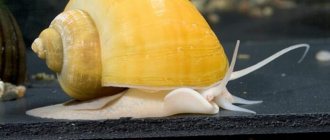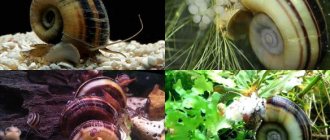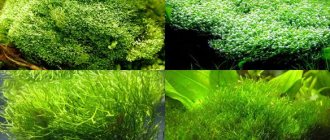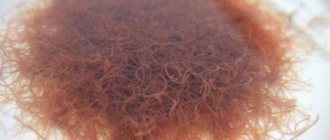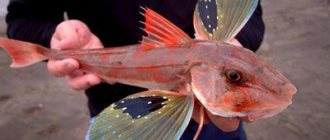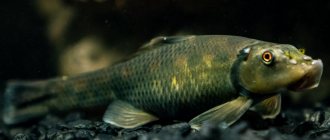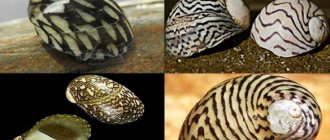Watching life in the underwater world is a pleasant experience. For some lovers, it is enough to contemplate the fish in their aquarium, which swim among many plants.
Others try to add variety by adding crustaceans and molluscs. Snails are by nature an interesting subject to study. For example, in Ancient Greece, snails were used for medicinal purposes.
Appearance
Physa is a freshwater gastropod. Distribution: Southern Europe, Central and Eastern Asia, North Africa. They live in warm waters with slow currents or in lakes and ponds. Small size: in the wild the body length reaches no more than 2 cm, and in an aquarium 1 cm. Appearance:
- shell: yellow-brown color. The shape can be round, pointed or conical (depending on the type). The coils are twisted to the left (this is rare among other types; usually the coils are directed from left to right). The wall is very thin and at first glance appears transparent;
- pseudopod black or blue;
- breathe with the help of the lungs and partially through the mantle;
- the tentacles differ from other mollusks: mobile, thin, located far from each other.
Like all gastropods, Physa has a radula in its mouth. This organ performs the functions of the tongue and teeth. Unlike predatory snails, the teeth are small. Vision and hearing are poorly developed, but the sense of smell and touch is good.
Mr. Tail recommends: varieties
Fiza has few varieties:
- Pimply (the second name is pimply) - the dimensions of its “house” are small: height up to 10 mm, width – 8 mm, in a home pond it grows only up to 9 mm. The shape is oval with 3-4 turns, fragile, yellow-chestnut or copper-brown, and the color of the snail is blue-black.
- Pointed - a shell with 5 curls, up to 17 mm high and 9 mm wide, round, hard, with an acute angle at the end, brick-pink in color. The body of the snail is a marsh shade with golden speckles.
- Marmorata - only 15 mm, thin shell, 4 turns, conical shape with marble streaks, dark gray mollusk.
- Red - a decorative species, imported from Australia, the shell is large, bright red, the apex is sharp. It reproduces slowly and does not eat leaves.
Table of basic parameters of maintenance, care and nutrition:
| What should be the volume of the aquarium? | from 1 liter per 1 individual |
| What should be the temperature in the aquarium? | from +20-28° C |
| pH | from 6.5-8 pH |
| What should the water hardness be? | from 5-15° dH |
| What should the substrate be? | Any will do, but preferably without sharp corners |
| What kind of lighting should there be? | moderate |
| What should be the movement of water | moderate |
| Maximum snail size | up to 2 cm |
| What do aquarium snails eat? | aquarium plants; food for fish; vegetables |
| Type of aquarium snail | peaceful |
| Who is compatible with in an aquarium? | compatible with all peaceful aquarium inhabitants |
| Lifespan | up to 11-14 months, but this depends on the conditions of detention |
Living conditions
Aquarium physa snails at home have the following water requirements:
- The temperature should be from +20 to +30 degrees.
- Water hardness is at a moderate level.
A characteristic feature of this species is the ability to create threads from their mucus, which they attach to plant leaves, stones, and snags, thereby creating a path for themselves leading to the surface of the water. However, the thread is so thin that sometimes it is almost impossible to see it in the aquarium.
This adaptation is necessary for the snail in order to be able to move to the surface in a short period of time. This necessity is due to the fact that the snail breathes air. For 15-20 days, the thread created by the snail is preserved, and the physes can safely move along it.
Maintenance and care
Physes are unpretentious in care. As with other animals in the aquatic environment, there are a number of factors that influence the life of mollusks. Gastropods can be found either in a common or in a separate vessel. For this there is one requirement: the volume must be calculated so that there is at least 1 liter of water per snail. Any soil will do, but preferably without sharp corners.
To get enough oxygen, snails often swim to the surface of the water; they do not have gills. You cannot keep the aquarium open, as the fish may escape. The lid should always be closed, but you need to leave a small gap so as not to completely block the access of oxygen.
A filter and an air compressor are a must. Water indicators:
- temperature from +20-28° C. In cooler water, snails fall into stupor, as all vital processes slow down;
- hardness from 5-15° dH;
- acidity from 6.5-8 pH;
- mandatory water changes of 20% of the volume every week.
Acidity and hardness play an important role in the content of physics. Soft water with high acidity destroys the shell. They can get sick: a fungal coating appears on the sink. Infected individuals are relocated and treated with weak sodium chloride. If there are signs of disease in the aquarium, wash the vegetation and change the water.
Description
The main difference between Fiza and other mollusks is the size of the shell. Having fragile and thin walls, its length is no more than 2 cm. The shape of snails is usually round or ovoid. Physa is one of the most popular aquarium snails. This is due not only to its unusual appearance, but also to other features. Now let's talk about everything in order.
The main difference between Fiza and other mollusks is the size of the shell.
What they look like
Physa belongs to the gastropod mollusks. It has a small smooth shell, painted in a light silver color. The snail itself can have different colors, for example, yellow or brown. Pink snails are less common. From the general dark background of the snail's body, small light spots can be seen. Physa, like most of its relatives, has thin thread-like tentacles, the main ones of which have visible eyes. The snail's body is soft, often colored gray, although black specimens can also be found. Sometimes there are light spots on the body.
Physa is a gastropod
Features of snails
end up in an aquarium in different ways, for example, together with decorative elements or plants. The thing is that their eggs stick to the surface of purchased plants and are carried into the tank. Physes create threads from their mucus that fill their entire habitat. These threads serve as a path along which the mollusks move in the aquarium, and can be attached to the leaves of underwater plants, stones or even to the bottom substrate . They do not have gills , so periodically the snail must rise up for a breath of air.
Varieties
There are many types of Fiza snails, but not all of them settle in the aquarium. Let's look at the most common types.
- Fisella red. Differs in habitat. The snail loves warm water because it was brought from the subtropics.
- Marmorata. A small snail with a conical shell. Typically, the shell is yellow or brown. The snail's body is gray.
- The physis is pointed. A fairly large species of snail, the pointed shell of which can reach 1.7 cm. The body is grayish, and the shell is most often brown, sometimes pink.
- Physa vesicularis. Another type of snail. The size of the shell can range from 0.1 to 1.5 cm. Unlike other species, the vesicular Physa has a dark body, sometimes with a blue tint. Shell color is brown or yellow.
Aquarium snails
Note! These types of snails are most often grown in aquariums, as they are less fastidious.
Content Features
For one snail you need an aquarium with a volume of at least a liter. If you plan to keep several individuals , then it is advisable to purchase a 10-liter aquarium for them. The water temperature in the tank should be in the range of 22-28 °C. If the temperature is lower than recommended, then all the life processes of the snail will slow down. The aquarium must have plants, such as detritus, green algae and diatoms.
Signs of Diatoms
Feeding
In short, Fizas are very gluttonous. They eat almost everything they find in the aquarium: the top layer of leaves, algae and even fish food. In this case, the decorative appearance of the gnawed plants is naturally lost. It is recommended to add pureed vegetables or herbs to the aquarium. To make the shell durable, you can add calcium carbonate to the aquarium ( food chalk or regular eggshells will do).
On a note! Even if there is enough food in the aquarium, the snails still crawl around the perimeter in search of remaining organic matter.
Eggshells for snails
Snail compatibility
They get along well with other types of snails (we are talking about herbivorous individuals), but Fiza should not be kept in the same aquarium with predatory species of fish or shellfish. It is also not recommended to add snails to fish that lay eggs . The fact is that Physes can damage it.
Physes get along well with other types of snails
Possible diseases
Fiz's shell is quite thin, so even minor mechanical impacts can damage it. To improve the process of formation of a protective cover, special vitamin supplements are added along with the food, which must contain carbonate . The duration of the recovery course is 4 weeks.
Snails can also suffer from fungal plaque. When it appears, infected individuals must be moved to a separate tank and treated with a special solution (most often aquarists use sodium chloride). When a disease is detected, the water in the aquarium must be changed, and all decorative elements and aquarium plants must be thoroughly washed.
Fiz's shell is quite thin TOP 11 unpretentious aquarium fish TOP 10 largest aquarium fish TOP 20 beautiful aquarium fish TOP 12 most expensive aquarium fish
How long do they live
Physes cannot boast of their longevity, since the average life expectancy is only 1-2 years. But this applies to aquarium snails. In their natural habitat they do not live that long.
Cost of snails
Due to their rapid reproduction rate, many aquarists give them away for free. But in pet stores you can buy the Fiza snail for about 10 rubles. It is advisable to buy at least two individuals. Soon there will be many more of them in the aquarium.
Fiza snail for about 10 rubles
What to feed
Gastropods are not picky eaters, but have a good appetite. They can feed on food that settles at the bottom. They love to eat the remains of plants and algae.
As a top dressing, you can give fresh herbs, vegetables, and tablets for catfish. Vegetables must be poured with boiling water for 5-10 minutes to disinfect.
To make the shell stronger, add crushed eggshells or food chalk.
Physa's brain is designed in such a way that it remembers the location of food and can return to it an hour later.
How to distinguish a male from a female and how to reproduce in an aquarium
Physa snails are not heterosexual mollusks. Their bodies contain male and female reproductive cells. When talking about other gastropod species, sex can be distinguished in several ways:
- turn the sink over. When the snail emerges, a process will be visible on the left side of the mantle - this is the male;
- according to the shape of the shell. In males it has the shape of a circle;
- during mating. The male crawls onto the female.
Physes reproduce in any conditions and all year round. They are hermaphrodites, so two individuals are enough for breeding, and sometimes even one. Snails exchange seminal fluid. After which, with a short break of up to 2 days, it lays more than one clutch of eggs on plants and driftwood. The size of one egg is about 5 mm. The incubation period lasts from 2 to 4 weeks at temperatures between +20-24° C.
When the same snails live in an aquarium for a long time, the offspring become red because the same population interbreeds. Life expectancy is 11-14 months.
Compatibility in the aquarium with other snails, shrimp and fish
If Fiza is in a common vessel, you need to pay attention to the proximity to other inhabitants. Ideal roommates would be non-predatory aquarium snails and peace-loving fish: Danios, Neons, Guppies, Norman's Blue-Eyes.
Keeping shellfish with fish such as Gourami, Cichlids, Geophagus, as well as some crustaceans (for example, macrobrachium shrimp) will lead to the complete extermination of individuals.
It is impossible for Fiza to be in the aquarium during fish spawning. While moving, it can touch the eggs and destroy their fragile shell.
Benefits and harms
The Fiza snail is not as harmless as it might seem at first glance. If you decide to deliberately diversify your aquarium with these mollusks, think about all the advantages and disadvantages of keeping them.
Pros:
- do not need a large aquarium;
- other inhabitants can feed on them;
- maintain cleanliness in the container by eating leftover fish food, plaque on the walls and snags;
- attractive in appearance;
- signals additional aeration: if it constantly floats near the surface of the water, this indicates a lack of oxygen.
Minuses:
- favorite delicacy is plants, thereby being a threat to them;
- uncontrolled reproduction, which creates a biological burden;
- dangerous for fish eggs;
- waste products float on the surface of the water, which leads to cloudiness.
A remarkable feature of snails.
It lies in the fact that the physis is capable of producing thin but strong cobwebs - cords. In this way, she marks her habitat and increases her comfort of existence. Threads of mucus are a kind of stairs or escalator for the physical body. Extracting an adhesive thread from its own body, the physa attaches it to a pebble or to the bottom leaf of a plant. Then she slowly rises to the surface, stretching the rope behind her. And already at the surface, the second end is attached to the top leaf of the same plant. The snail then repeats this procedure several times. As a result, the little worker gets a strong and durable road for quick descent and ascent. It must be said that simply observing the construction of such a rope system is very interesting and educational! Children especially like this, helping them to better understand and love living nature.
How to get rid
Snails are often unwanted guests in an aquarium. They appear in different ways: together with plants and decor from another aquarium or natural reservoir.
Physes harm vegetation, so aquarists are often ready to use any method to get rid of them. It all depends on whether the snails are in a separate aquarium or together with other fish. Here are some methods:
- launch predators that feed on shellfish. The method is not always convenient, as it requires the creation of special conditions for new inhabitants. Other inhabitants may also be harmed;
- chemicals. Due to toxicity, care must be taken not to harm other inhabitants;
- mechanical method. Place a trap in the water: for example, a banana peel. The snails will crawl to it to eat and you can easily pull them out of the water along with the bait. But if there are eggs left in the aquarium, after a while the mollusks will appear again;
- clutches of eggs can be eaten by Ancistrus;
- reduce feeding. You won’t get rid of the fish completely, but you will reduce the population;
- radical measures. Disinfect the soil and all decorations, or replace them completely.
Breeding
When they are placed in an aquarium, they breed on their own. In warm water of 20 - 25 degrees, gastropods carry out several clutches of eggs. Therefore, very quickly the walls of the aquarium and the plants become covered with mucus bags. Development lasts from 12 to 14 days. After the first laying, the second, then the third, follows at a short interval. Under favorable conditions, mollusks reproduce throughout the year. The number of individuals is rapidly increasing, and if there are no fish in the aquarium that eat the snails, then you will have to remove the fertile gastropods yourself. To prevent snails from filling the entire tank, it is necessary to regulate their population.
Sex differences
The aquarium snail physa belongs to hermaphroditic organisms. One individual has both female and male gonads. There are no gender differences.
Reproduction
Physae are hermaphrodites; their gonads are unpaired. Mating comes down to the exchange of seminal fluid, which is transferred to the spermatheca of another individual.
Fertilized eggs are covered with membranes and form a clutch enclosed in a mucous cocoon. Several dozen eggs are attached to leaves and stones. The life cycle is one year.
Fertilized eggs are covered with shells and form a clutch enclosed in a mucous cocoon
Juveniles are observed in reservoirs in late summer and early autumn. After wintering, usually in late spring or summer, new clutches appear in the water. Environmental temperature determines the timing of reproduction in different habitats.
Getting offspring
You can get offspring from individuals without special conditions; having a couple of individuals is enough. Adult snails lay up to 20 eggs. The eggs are found in mucous packets that are attached to the leaves. Development of the embryos lasts two weeks. Small snails with microscopic shells appear. They feed on bacterial film, then detritus.
Watch the video about Fiza:
Conclusion
It’s always interesting when not only fish swim in an aquarium, but also other representatives of the aquatic environment. They are all beautiful and unique in their own way.
Phyza the snail is a common resident and may end up as an unexpected guest. Here you need to decide whether to leave it or not. There are no special requirements to keep a mollusk. The main thing is that the water is clean, warm enough and enriched with oxygen. Do not allow acidity to increase, this will destroy the shell. There are also no strict rules in feeding. Anything will do: pasture, plants.
Share with friends on social media. networks
10% DISCOUNT FOR BUYERS FROM REGIONS OF RUSSIA AND CIS COUNTRIES FOR AQUARIUMS, FISH, PLANTS, ETC.
What are the benefits and harms of physeal snails?
The Physus snail is of great benefit to the artificial reservoir and its underwater inhabitants. It provides:
- destruction of dead vegetation and food residues;
- cleaning the walls of the tank from plaque;
- prevention of algae growth.
In fact, phys snails act as orderlies and cleaners of the aquarium. At the same time, they can cause harm:
- destruction of green spaces;
- absorption of fish eggs;
- Too rapid reproduction, leading to overpopulation of the aquarium.
If you want to get rid of Physus snails or reduce their numbers, you can put banana peels in the aquarium overnight. In the morning all that remains is to remove the skin covered with shellfish from the aquarium.
The Physus snail is an interesting and unusual mollusk, which still brings more benefit than harm, and in addition, does not require attention or special care.
